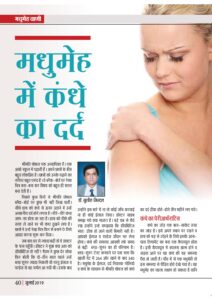
– Dr. Sushil Jindal, Endocrinologist, Diabetologist, Consultant Physician
It is generally believed that tuberculosis (TB) is a disease of weak and poor. In diabetics this is not true. TB both in lungs and outside lungs is 3 to 4 times more common in diabetics as compared to non-diabetics. It can afflict relatively well maintained and well to do diabetic individuals also.
Why more common in diabetics :
TB is caused by bacteria – mycobacterium tuberculosis. Transmission of these bacteria is predominantly airborne. In country like India, exposure to these bacteria is universal. What determines the possibility of producing disease is host defense system. Host defense becomes weak due to malnutrition or chronic debilitating diseases, giving the chance to bacteria to proliferate and produce the disease.In diabetics immune system becomes weak due sustained increase in blood glucose. TB is more likely in diabetics who are poorly controlled. High glucose also makes TB more aggressive and increases the chances of developing drug resistance.
How Tuberculosis is different in diabetics :
- Symptoms of TB may be less pronounced.
- In diabetics lower lobes of lungs are commonly involved while in non-diabetics the apices upper lobes of lungs are more common site of disease.
- Disease may spread faster to other lung or outside lungs.
- Patients are more contagious to others. As the defense llllsystem is weak, the bacteria are multiplying fast, and are brought out in greater numbers in sputum and droplets.
- Disease is more aggressive.
- Drug resistance is more common.
- After treatment, chances of relapse are more, hence longer duration of treatment is recommended
When to suspect :
- Cough and expectoration (sputum) lasting for more than 2 weeks and not responding to usual antibiotic drugs.
- Rapid loss of weight, loss of appetite, weakness and night sweats.
- Fever, usually low grade with evening rise.Blood in sputum.
- Deterioration of blood glucose control with any above symptom.
- Chest pain particularly on coughing or sneezing.In case of abdominal TB, pain and fullness in abdomen.
- Recent contact with person suffering from TB.
How to confirm
- Chest X-ray (for lung TB).
- By checking AFB (TB bacteria) in sputum.
- Sonography, CT-Scan, MRI-Scan for organs other than lungs.
- For pleurisy and abdominal TB, fluid may be drawn from these and sent for examination.
- Sometimes biopsy and culture for TB bacteria may be required.
What other organs than lungs may be involved
- Pleura – fluid sac outside lungs.
- Abdomen – intestines, lymphodes, peritoneum (membrane in abdomen).
- Brain – membrane (meningitis), brain substance (tuberculoma).
- Genitourinary system – kidney, bladder, internal sex organs.
- Lymph nodes often in neck.
- Skin.
How Treated
- Most important is good blood glucose control, otherwise TB drugs would not be effective and chances of developing drug resistance would be high.
- If patient is not on insulin, it is always better to start insulin at least for few months initially.
- Standard anti TB drugs in proper doses (4 drugs to start with).
- Instead of standard 6 to 9 months of anti TB treatment, in diabetics it is recommended that treatment be given for 12 months.
With modern anti-TB drugs, insulin and tight blood sugar control, almost all diabetics can be successfully treated for tuberculosis and lead a normal life. What is important is to timely suspect and diagnose this disease in diabetics.










